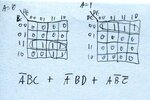aliraza786
Full Member level 4
- Joined
- Nov 10, 2009
- Messages
- 210
- Helped
- 14
- Reputation
- 28
- Reaction score
- 14
- Trophy points
- 1,298
- Location
- Lahore, Pakistan, Pakistan
- Activity points
- 2,914
A digital circuit which detect when input binary number is from 9 to 19 range
i wana design a circuit which can detect when the input is greater then 9 and up to 19 ......i dnt know how to use k map for five variable....can any one help me how can i use CAD tools to make such types of circuits instead of usng k map..becuse a professional approch is CAD tools..........
i wana design a circuit which can detect when the input is greater then 9 and up to 19 ......i dnt know how to use k map for five variable....can any one help me how can i use CAD tools to make such types of circuits instead of usng k map..becuse a professional approch is CAD tools..........

